Physical Address
304 North Cardinal St.
Dorchester Center, MA 02124
Neurolytic therapy, for the appropriate patient, may result in significant improvement of quality of life and possibly improved function. Few other interventional pain therapies have such extreme risk/benefit profiles requiring targeted patient selection and meticulous procedural technique. Evaluating neurolysis as a therapeutic option is usually reserved for end-stage therapy, primarily for patients with refractory cancer pain resulting from the possibility of severe side effects. For instance, neuraxial neurolysis can provide profound pain relief for patients with pain related to invasive tumors involving the pelvis, but this approach often also leads to loss of bowel or bladder function and may well also produce weakness in the lower extremities. It should also be emphasized that relief from neurolytic blocks is usually not complete, as most patients with cancer pain have multiple sources of their pain. Neuraxial neurolysis is an important treatment modality for patients in extremis . Neurolytic agents available in the United States for common use in the neuraxis include ethanol and phenol. The five criteria for neurolysis are (1) the presence of severe pain, (2) the failure of less invasive techniques to relieve the pain, (3) the presence of well localized pain, (4) the relief of pain with diagnostic local anesthetic blocks, and (5) the absence of undesirable effects after diagnostic blocks ( Box 63.1 ).
Pain is severe and unremitting
Pain is unresponsive to medical management
Pain is relieved with diagnostic blocks using local anesthetic
No undesirable effects appear during local anesthetic blocks
Pain is well localized
Pain affects the patient’s function
Patient is not a candidate for neuraxial medication delivery systems
Patient has failed neuraxial medication delivery
The patient can perform informed consent or has appropriate advance directive
Neurolytic blocks can be peripheral, neuraxial, or visceral. Of the three, visceral blocks are most commonly performed. In the case of peripheral neurolytic nerve blocks, blocking mixed motor and sensory nerves can cause motor deficits leading to loss of functionality for the patient. In addition, peripheral neuritis and deafferentation pain are potential painful consequences, whereas the block itself is not predictably permanent. Finally, the patient may also be dissatisfied with the subsequent numbness of the area and complain of symptoms of anesthesia dolorosa . Neuraxial neurolytic blocks, including intrathecal and epidural alcohol or phenol neurolytic blocks, are rarely used today because neuraxial analgesics including opioids, local anesthetics, and clonidine can effectively and safely be used to treat cancer pain. Where an intrathecal drug delivery system can provide widespread pain relief that can be adjusted to accommodate many scenarios, a successful neurolytic block may have to be repeated with changes in the pathologic condition, such as the presence of new metastatic lesions. In such cases, it is impractical to perform subsequent subarachnoid neurolytic injections because of their attendant risks, whereas an indwelling intrathecal (and occasionally epidural) drug delivery system will cover new areas of pain and continue to be useful. In contrast, neurolytic blocks have a less financial burden than implantation of intrathecal drug delivery systems.
While neurolytic blocks are effective in treating visceral pain syndromes, there may be less efficacy or shorter duration of effect when treating somatic pain syndromes or lymphatic pain syndromes. Stretching, compressing, invading, or distending visceral structures can result in poorly localized, noxious visceral pain. Patients experiencing visceral pain often describe the pain as vague, deep, squeezing, crampy, or colicky. Other signs and symptoms include referred pain (e.g. shoulder pain that appears when the diaphragm is invaded by a tumor) and nausea and vomiting because of vagal irritation.
Visceral pain associated with cancer may be relieved by oral pharmacologic therapy, which classically includes combinations of nonsteroidal anti-inflammatory drugs (NSAIDs), opioids, and co-adjuvant therapy (i.e. anti-convulsants and tricylic antidepressants). NSAIDs have fallen out of favor with some clinicians for the treatment of chronic pain because they have been implicated in thrombotic events. Besides pharmacologic therapy, neurolytic blocks of the sympathetic axis are also effective in controlling visceral cancer pain and should be considered as important adjuncts to pharmacologic therapy for the relief of severe visceral pain. These blocks rarely eliminate cancer pain because patients frequently experience somatic and neuropathic pain. Therefore oral pharmacologic therapy must be continued in the majority of patients with advanced stages of their disease. The goals of performing a neurolytic block of the sympathetic axis are to maximize the analgesic effects of opioid or nonopioid analgesics and reduce the dosage of these agents to alleviate side effects. This chapter reviews the technical approaches and pharmacologic agents used for neurolytic blocks, neuraxial neurolysis, and neurolysis of the sympathetic axis for cancer pain.
( Table 63.1 )
| Alcohol | Phenol | |
|---|---|---|
| Physical properties | Low water solubility | Absorbs water on air exposure |
| Stability at room temperature | Unstable | Stable |
| Concentration | 100% | 4%–8% |
| Diluent | None | Glycerin |
| Relative to CSF | Hypobaric | Hyperbaric |
| Injection sensation | Burning pain | Painless, warm feeling |
| Onset of neurolysis | Immediate | Delayed (15 min) |
| CSF uptake ends | 30 min | 15 min |
| Full effect of neurolysis | Three to five days | One day |
| CSF, Cerebrospinal fluid. | ||
Ethyl alcohol (ethanol) is the classic neurolytic agent first reported by Dogliotti in 1931 for intrathecal injection. Anhydrous ethanol is commercially available undiluted (approximately 100% concentration) but will absorb a small amount of water from the air upon exposure to the atmosphere. Although neurolytic blocks have been shown to require a concentration of 33% or greater to effect neurolysis, the most common concentrations used are ≥80% when diluted with contrast medium or local anesthetic. The neurolytic action of alcohol is produced by the extraction of neural cholesterol, phospholipids, and cerebrosides, and the precipitation of mucopeptides. These actions result in sclerosis of the nerve fibers and myelin sheath, leading to demyelination. The basal lamina of the Schwann cell sheath remains intact, allowing for new Schwann cell growth, thereby providing the framework for subsequent nerve fiber growth. This framework encourages the regeneration of axons, but only if the cell bodies of these nerves are not completely destroyed. The pathway of degeneration is nonselective and can be observed in peripheral nerves and spinal nerve roots following intrathecal injection. Areas of demyelination can be seen in posterior columns, Lissauer’s tract, and the dorsal root, followed by Wallerian degeneration to the dorsal horn. Intrathecal alcohol injection results in rapid uptake of alcohol and variable injury to the surface of the spinal cord.
Ethanol is quickly absorbed from the cerebrospinal fluid (CSF) so that only 10% of the initial dose remains in the CSF after 10 min and only 4% after 30 min. The rapid spread from the injection site means larger volumes are required than for phenol, which in turn may result in local tissue damage. In the case of celiac plexus blocks, alcohol is rapidly absorbed into the bloodstream. It has been shown that serum ethanol levels up to 54 mg/dL can occur after a celiac plexus block. However, following the intrathecal administration of alcohol, it is unlikely there will be significant vascular uptake. Ethanol has a specific gravity of less than 0.8, and CSF has a specific gravity of slightly greater than one. Within the CSF, alcohol is hypobaric and will move against gravity, “floating” upward. Therefore positioning of the patient is an extremely important factor to consider when planning the procedure.
The use of ethanol as a neurolytic agent has been associated with a disulfiram-like effect, acetaldehyde syndrome. Case reports include patients taking moxalactam, a b-lactam antibiotic that inhibits aldehyde dehydrogenase, documented disulfiram-like effects, and another taking 1-hexyl carbamoyl-5-fluorouracil, an anticancer drug, experienced similar symptoms. The patients experienced flushing, hypotension, tachycardia, and diaphoresis within 15 min of alcohol administration. The symptoms resolved 4–6 h later, and efforts were undertaken to stabilize hemodynamics. Both cases occurred after celiac plexus blocks. The pain practitioner needs to recognize medications that may cause disulfiram-like effects, such as chloramphenicol, b-lactams, metronidazole, tolbutamide, chlorpropamide, and disulfiram, after peripheral neurolytic blocks with alcohol.
Perineural administration of ethanol is associated with burning dysesthesias in the distribution of the nerve. This sensation is often extremely unpleasant for the patient and can last from a few minutes to a few weeks. To alleviate this outcome, local anesthetic is administered prior to the use of ethyl alcohol. The use of this initial dose of local anesthetic can also provide diagnostic guidance on the correct location for the neurolytic that has enormous importance. The administration of ethanol for the purpose of neurolysis can have catastrophic consequences. It has been associated with both transient and permanent paraplegia in both celiac plexus and intrathecal blocks. It has been postulated that these effects are secondary to vasospasm of the spinal arteries by the direct action of alcohol or direct damage to the spinal motor nerves.
Phenol has a benzene ring with one hydroxyl group substituted for a hydrogen atom. It is usually prepared by the hospital pharmacy because it is not commercially available in premixed liquid form. Phenol is poorly soluble in water and, at room temperature, forms only a 6.7% aqueous solution. It has a shelf life of approximately one year if refrigerated and shielded from light exposure. When phenol is exposed to room air, it oxidizes and turns a reddish color. Phenol is frequently prepared with sterile water, sterile saline, or glycerin. When prepared with glycerin, it has limited anatomic spread, and, hence, injections are well localized. In rats, the aqueous solution of phenol has a greater ability to penetrate the perineurium and produce greater endoneurial damage than glycerin preparations, but there is no difference in the results following intraneural injection. Unlike alcohol, phenol injection has an initial local anesthetic effect. It is not associated with localized burning but instead creates a sensation of warmth for a short time after injection. The distribution of this sensation can help the practitioner verify proper needle placement similar to a diagnostic local anesthetic injection. Concentrations of 4%–10% are typically used for neurolysis. When phenol is prepared in glycerin, it has a specific gravity of 1.25, making it hyperbaric. Preparations of phenol in glycerin are highly viscous, which may make administration through a small (22- or 25-gauge) spinal needle difficult.
Putnam and Hampton first used phenol as a neurolytic agent in 1936. Mandl used it for a sympathetic ganglion block in animals in 1947. Phenol was first used as a medication in an intrathecal injection in humans in 1955. It was once believed that phenol’s neurolytic effects might be because of local ischemia because of its greater affinity for vascular tissue than neural tissue. , Racz found that, unlike epidural injection, tissue destruction resulted after intrathecal injection even though the vasculature was intact in the areas of spinal cord destruction. This finding points toward direct neurotoxic effects rather than effects secondary to local ischemia. Phenol’s effects may be a combination of direct neurotoxic and ischemic effects. Originally, it was surmised that phenol had a selective effect on small-diameter, unmyelinated nerve fibers, such as c-fiber afferents and lightly myelinated A-δ afferents. Subsequent studies have shown that phenol concentrations determine the type and extent of nerve disruption. Dilute intrathecal phenol can produce a transient local anesthetic blockade, whereas increased concentrations can produce significant neural damage. At concentrations <5%, phenol results in protein denaturation of axons and surrounding blood vessels. At concentrations >5%, phenol can produce protein coagulation and nonselective segmental demyelination. Nathan confirmed the nonselective effects of phenol using histologic studies combined with evidence of electrophysiologic changes to Aα and Aβ fibers. Smith showed that intrathecal phenol injections in cats and humans primarily destroyed axons in dorsal rootlets and the dorsal columns of the spinal cord. It was also noted to exert some effects on the ventral root axons. Maher and Mehta noted that motor blocks by phenol were possible at concentrations greater than 5%, whereas intrathecal injections of less than 5% produced mostly sensory blocks. At higher concentrations, the extent of damage can increase significantly, with the potential of axonal nerve root damage and spinal cord infarcts. Injections of high concentration phenol have also been associated with arachnoiditis and meningitis.
Systemic doses of phenol over 8.5% are associated with toxic side effects. These effects initially are convulsions, followed by central nervous system depression, and, finally, cardiovascular collapse. Chronic long-term exposure may be associated with renal toxicity, skin lesions, and gastrointestinal effects. However, phenol is not classically used in long-term settings, and the customary doses of less than 100 mg are unlikely to produce any systemic effects.
Compared to alcohol, phenol seems to facilitate axonal regeneration in a shorter period. Electrophysiologic studies comparing peripheral nerve destruction in cats showed that those injected with phenol had returned to normal by two months, whereas at the end of the same period, those injected with alcohol still demonstrated depression of compound action potentials.
Glycerol is a colorless, odorless, viscous, liquid, polyol compound. It has three hydroxyl groups that result in high water solubility, and it is hygroscopic in nature. The glycerol backbone is central to all lipids known as triglycerides. When placed on nervous tissue, myelin disintegration and axonolysis occur in both myelinated and unmyelinated fibers. In the uninjured nerve, the c-fiber and lightly myelinated fibers are the most sensitive to neurolysis, requiring higher concentrations to destroy the heavily myelinated fibers. However, this order is altered in the injured nerve; the heavily myelinated fibers become very sensitive to the neurolytic properties of glycerol. In 1981 Hakanson was the first to use glycerol for neurolysis of the trigeminal ganglion. The success is most likely related to a combination of the viscous nature of glycerol and resultant lack of spread into other sensitive structures, the low concentration required to destroy the abnormally firing myelinated fibers while preserving the uninjured sensory afferents. The use of glycerol for neurolysis is now primarily restricted to the neurolysis of the Gasserian ganglion.
Neurolytic agents can be injected surrounding the peripheral nerves, along the neuraxis within the intrathecal or epidural spaces, or adjacent to visceral sympathetic nerves. Each of these sites of injection is associated with specific benefits, risks, and complications. Peripheral neurolysis can include injection into the trigeminal ganglion, truncal, upper, and lower extremities.
Peripheral nerves in the head and neck are destroyed for a variety of reasons. These include blockade of the trigeminal ganglion for trigeminal neuralgia that is not responsive to medical management and for relief of cancer pain secondary to invasive tumors of the orbit, maxillary sinus, and mandible, and blockade of individual peripheral nerves in the head.
The Gasserian ganglion is formed from two trigeminal roots that exit the ventral surface of the brainstem at the midpontine level. The roots pass forward and in a lateral direction, in the posterior fossa of the cranium, across the border of the petrous temporal bone. It then enters the Meckel’s cave in the middle cranial fossa. The Gasserian ganglion contains the ophthalmic, maxillary, and mandibular divisions. A smaller motor root joins the mandibular division as it exits the foramen ovale. It should be noted that a dural pouch, the trigeminal cistern, lies behind the trigeminal ganglion. In Gasserian ganglion block, the needle is inserted approximately 2.5 cm lateral to the side of the mouth and advanced, perpendicular to the middle of the eye (with the eye in the mid-position) in a cephalad direction toward the auditory meatus. When contact is made with the base of the skull, the needle is withdrawn and “walked” posteriorly toward the foramen ovale ( Fig. 63.1 ). A free flow of CSF is usually noted, and fluoroscopy is then used to confirm the correct needle placement. Very small amounts (i.e. 0.1 mL increments) of local anesthetic or neurolytic agent (commonly glycerol) are injected to a total of 0.4–0.5 mL. Because of their different baricity, the patient remains supine if alcohol is used but placed in a sitting position with the chin on the chest prior to the injection of phenol. This maneuver localizes the phenol around the maxillary and mandibular divisions of the trigeminal nerve, avoiding the ophthalmic division and the risk of keratitis from loss of the conjunctival reflex. If glycerol is used, the patient is kept in a “seated”/head-up position. The pterygopalatine space is highly vascular, and significant hematoma of the face and subscleral hematoma of the eye can occur. Veins in the subtemporal region can be punctured, causing hemorrhage in the temporal fossa. Local anesthetic injection can lead to spinal anesthesia because the ganglion lies within the cerebrospinal fluid. Blockade of the motor fibers of the trigeminal nerve can interfere with mastication. Oculomotor palsy, which results in diplopia and strabismus, is usually temporary. Abducens palsy is also temporary, although cases of permanent lateral rectus palsy have been reported. Spread of the neurolytic agent into the facial nerve results in paralysis of the facial muscles and inability of the eyelid to close, resulting in keratitis or corneal ulceration. Blockade of the greater superficial petrosal nerve may result in a lack of tear formation and conjunctivitis. Blockade of the acoustic nerve may result in deafness or dizziness. The delayed effects of Gasserian ganglion neurolytic block include trophic problems such as keratitis, ulcerations in the nose, and erosions in the mouth. These disturbances usually occur after trauma to the area. Another delayed complication is anesthesia dolorosa seen more commonly with alcohol and phenol neurolysis. Because the neurolytic block of the Gasserian ganglion is associated with myriad devastating complications, many neurosurgeons and pain medicine physicians choose to perform radiofrequency rhizotomy of the ganglion instead. The technical difficulty and complications associated with Gasserian ganglion block led some investigators to perform peripheral branch (supraorbital, infraorbital, and mandibular nerves) injections with 10% phenol to relieve the pain of tic douloureux.
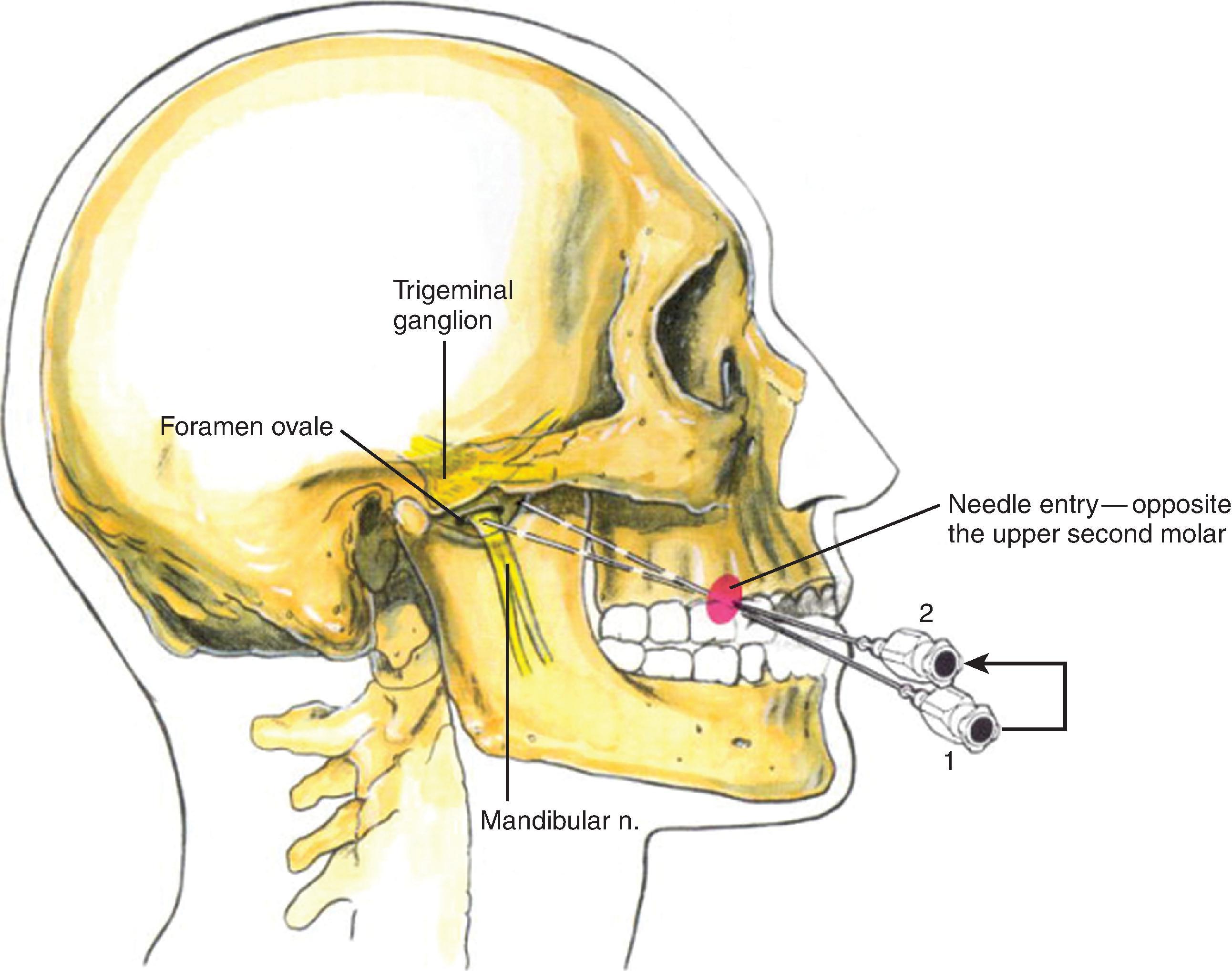
Neurolytic blocks of individual cranial nerves and their branches have also been performed, and complications are related to nerve location and the tissues it innervates. Neurolytic block of the maxillary nerve at the foramen rotundum or of the infraorbital nerve may cause ulceration and sloughing of the alar of the nose and the cheek, ischemic necrosis of the palate, or sloughing of the posterior portion of the superior ridge of the maxilla. Blockade of the mandibular nerve at the foramen ovale may result in weakness of the muscles of mastication in the blocked side, whereas blockade of the facial nerve causes weakness or paralysis of the facial muscles. Blockade of the glossopharyngeal nerve is rarely performed because of the proximity of the nerve to the vagus, spinal accessory, and hypoglossal nerves. The close location of the other nerves led investigators to recommend blockade of the glossopharyngeal nerve under fluoroscopic control or to use radiofrequency rhizotomy. The sensory area of innervation of the glossopharyngeal nerve includes the nasopharynx, eustachian tube, uvula, tonsil, soft palate, base of the tongue, and part of the external auditory canal. Paralysis of the pharyngeal muscles is a consequence of blockade of the glossopharyngeal nerve.
The cervical sympathetic trunk contains the superior, middle, and inferior cervical ganglia. In 80% of the population, the lowest cervical ganglion is fused with the first thoracic ganglion, forming the cervicothoracic (stellate) ganglion. The cervical sympathetic chain lies anterior to the prevertebral fascia, which encloses the prevertebral muscle ( Fig. 63.2 ). The sympathetic chain is enclosed within the alar fascia, a thin fascia that separates the cervical sympathetic chain from the retropharyngeal space. The carotid sheath is connected to the alar fascia by a mesothelium-like fascia. The fascial plane that encloses the sympathetic chain may be in direct communication with several spaces and structures, including the brachial plexus, vertebral artery, endothoracic fascia, and the thoracic wall muscle at T1–T2. At the C6 level, the cervical sympathetic trunk is located posterolaterally to the prevertebral fascia on the surface of the longus colli muscle (LCM). The carotid vessels are anterior, whereas the nerve roots that contribute to the inferior portion of the brachial plexus are lateral to the ganglion. The vertebral artery passes over the ganglion and enters the vertebral foramen posterior to the anterior tubercle of C6. The communications of the fascia covering the stellate ganglion with several structures, as noted previously, and the proximity of the stellate ganglion to the vertebral and carotid vessels, phrenic nerve, and the recurrent laryngeal nerve explain some of the potential complications of the stellate ganglion block ( Fig. 63.3 ).
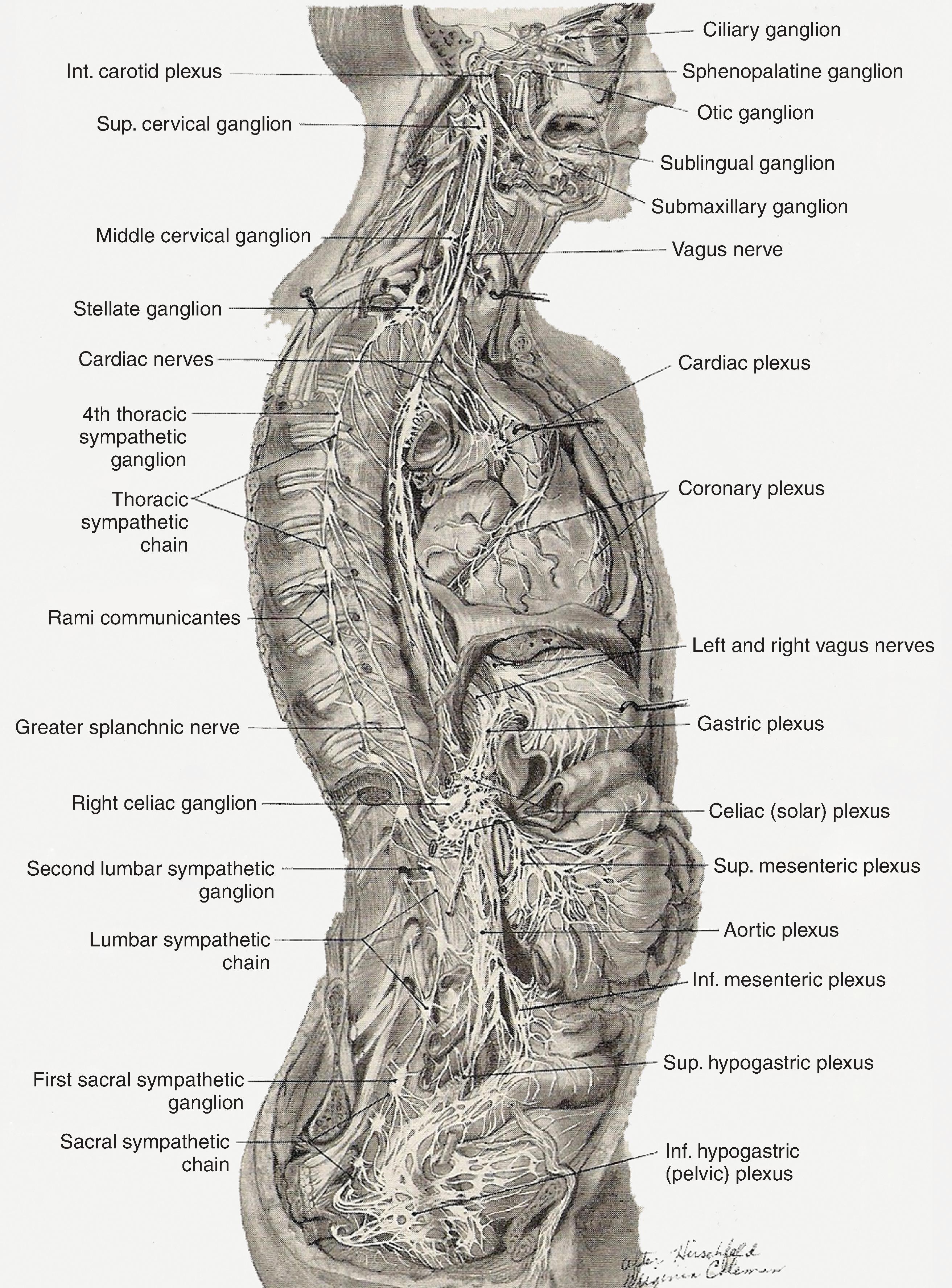
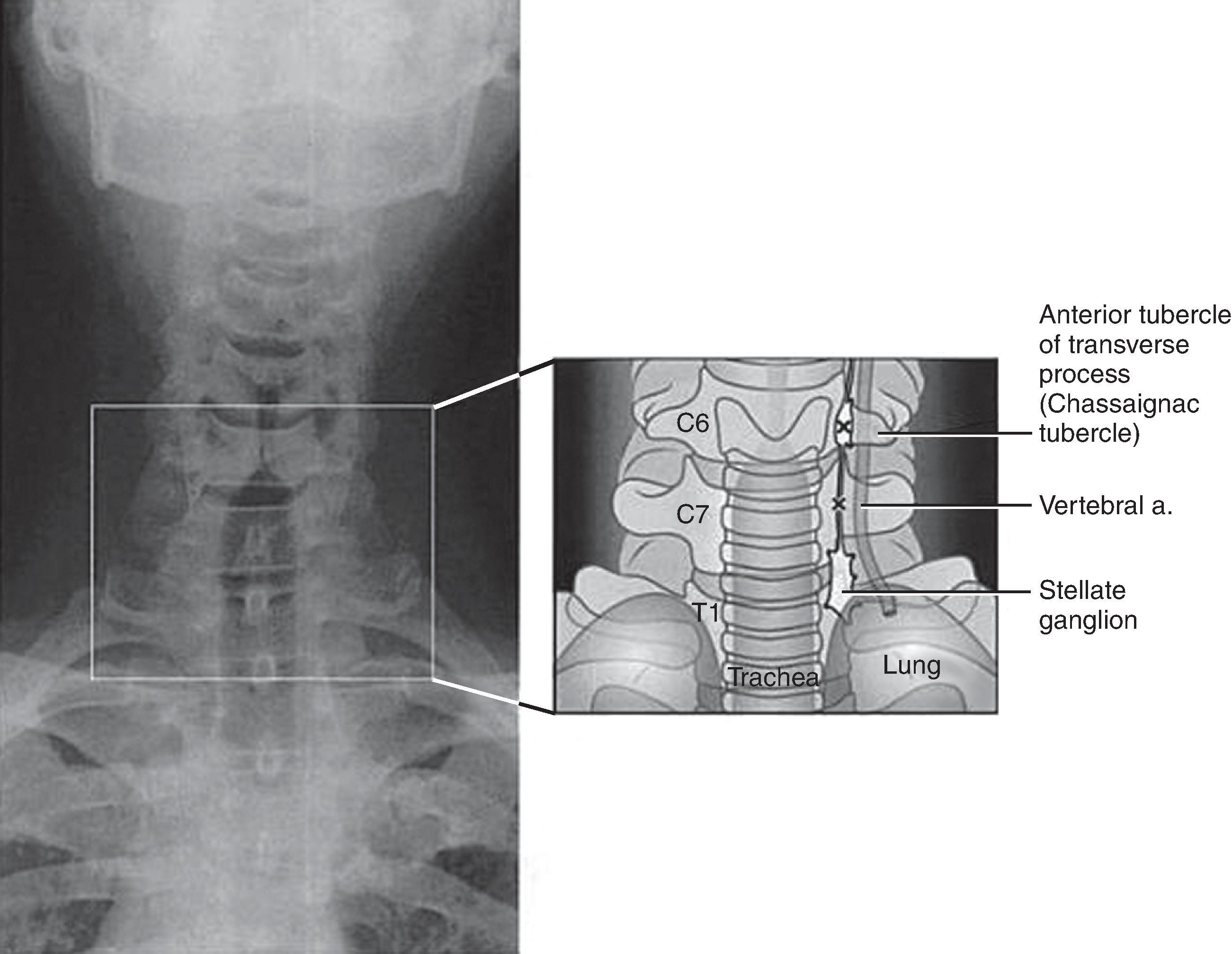
SGB is commonly used for the diagnosis and management of sympathetically mediated pain and vascular insufficiency of the upper extremity. In addition, more esoteric indications that have been advocated include the treatment of a variety of medical conditions, such as phantom pain, postherpetic neuralgia, cancer pain, cardiac arrhythmias, orofacial pain, and vascular headache. Recently, cervical sympathetic blockade has been suggested as an effective method for prevention and treatment of cerebral vasospasm, hot facial flushes, and post-traumatic stress disorder.
Several techniques of stellate ganglion block have been described. These include insertion of the needle at the level of C6, placement of the needle at C7, and the posterior thoracic approach. With C6 placement, the needle is placed in contact with either the C6 tubercle or the junction between the C6 vertebral body and the tubercle ( Fig. 63.4 ). The needle is withdrawn 1–2 mm, and an initial test dose of 0.5–1 mL is injected, or volumes of 5–10 mL can be injected. If the patient is positioned in reverse Trendelenburg, the injectate travels caudad and reaches the stellate ganglion and the upper thoracic sympathetic ganglia. A smaller volume of drug is adequate when the needle is placed at the level of C7. However, there is an increased incidence of vertebral artery injection with this approach because the artery lies anterior to the C7 transverse process. There is also an increased risk of pneumothorax because the dome of the lung is closer to the injection site. These risks are reduced when an oblique approach aiming at the uncinate process of C7 is taken. , The posterior thoracic approach requires fluoroscopic guidance to identify the lamina of T1 or T2, and dye injection is recommended to document the spread of the drug. In this approach, the needle contacts the lamina of T1 or T2, is moved laterally off the lamina, and is advanced to pass the costotransverse ligament at a depth of 2 cm beyond the lamina. Either loss of resistance is used, or dye is injected to confirm proper needle placement.
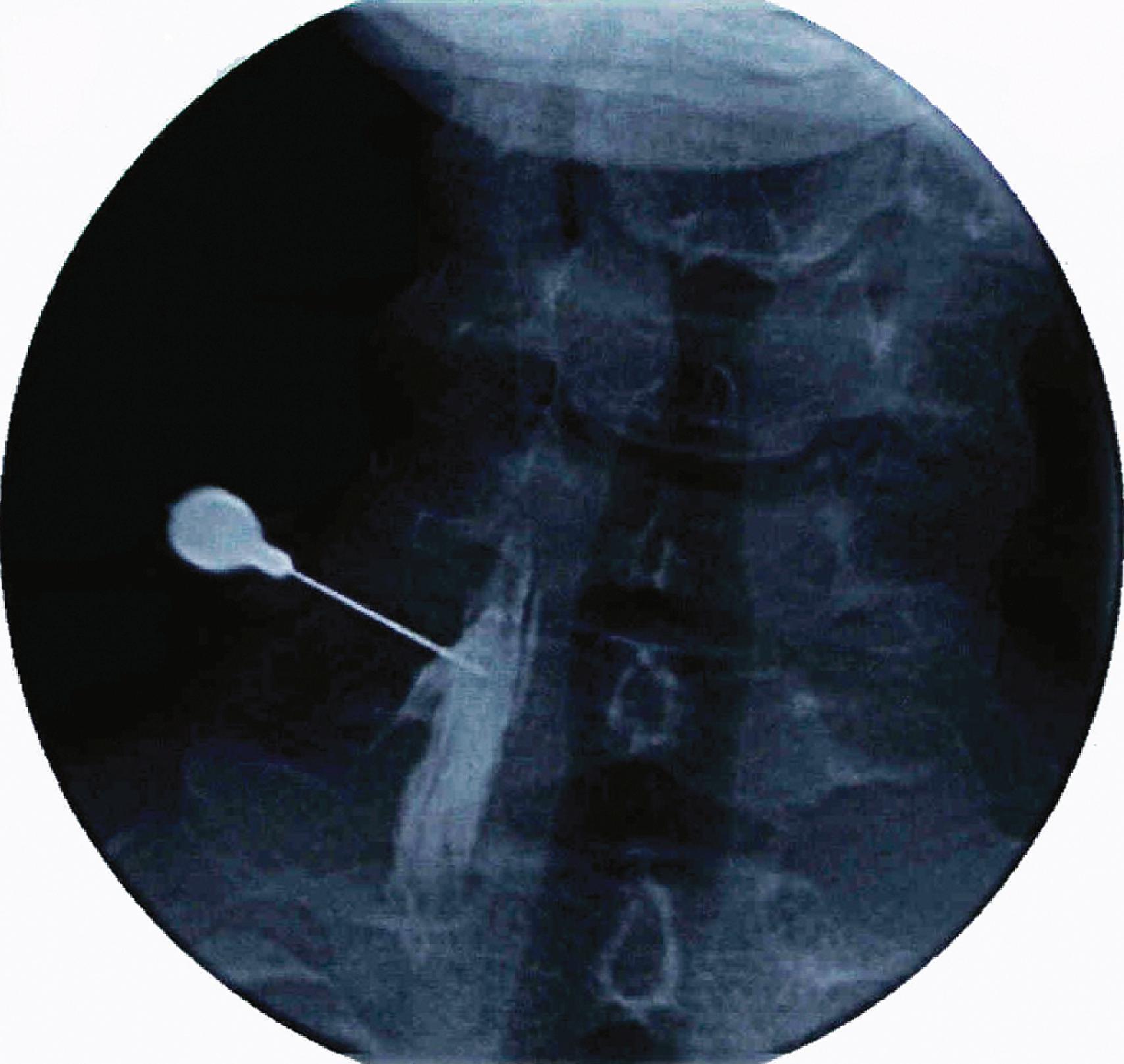
Kapral published an ultrasound guided technique involving the use of ultrasound to visualize the stellate ganglion. Since the initial technique was developed, many modifications have been made to increase the safety, efficacy, and speed of the block. , The patient is positioned supine with the neck slightly hyperextended, and an ultrasound probe is placed at the level of C6, providing a cross-section of the anatomy at this level ( Figs. 63.5 – 63.6 ). Visible are the trachea, esophagus, thyroid gland, carotid artery, jugular vein, LCM, and transverse process of C6. A 22G × 2 inch needle can be advanced in plane with the ultrasound probe paratracheally toward the LCM while avoiding the other structures and stopping once the tip reaches the prevertebral fascia. The needle is inserted under continuous ultrasound guidance and directed to the anterior surface of the LCM via a short-axis, out of plane approach. When the tip of the needle is visualized, either directly or indirectly (tissue movement) as the target is approached, 1–2 mL of saline is injected to confirm the placement of the needle under the prevertebral fascia and facilitate clear separation of the tissue planes ( Fig. 63.7 ). If the injectate is observed above the fascia or within the muscle, the needle must be carefully repositioned. If the spread is appropriate, 5–10 mL of local anesthetic is deposited under direct visualization and can be seen spreading along the prevertebral fascia.
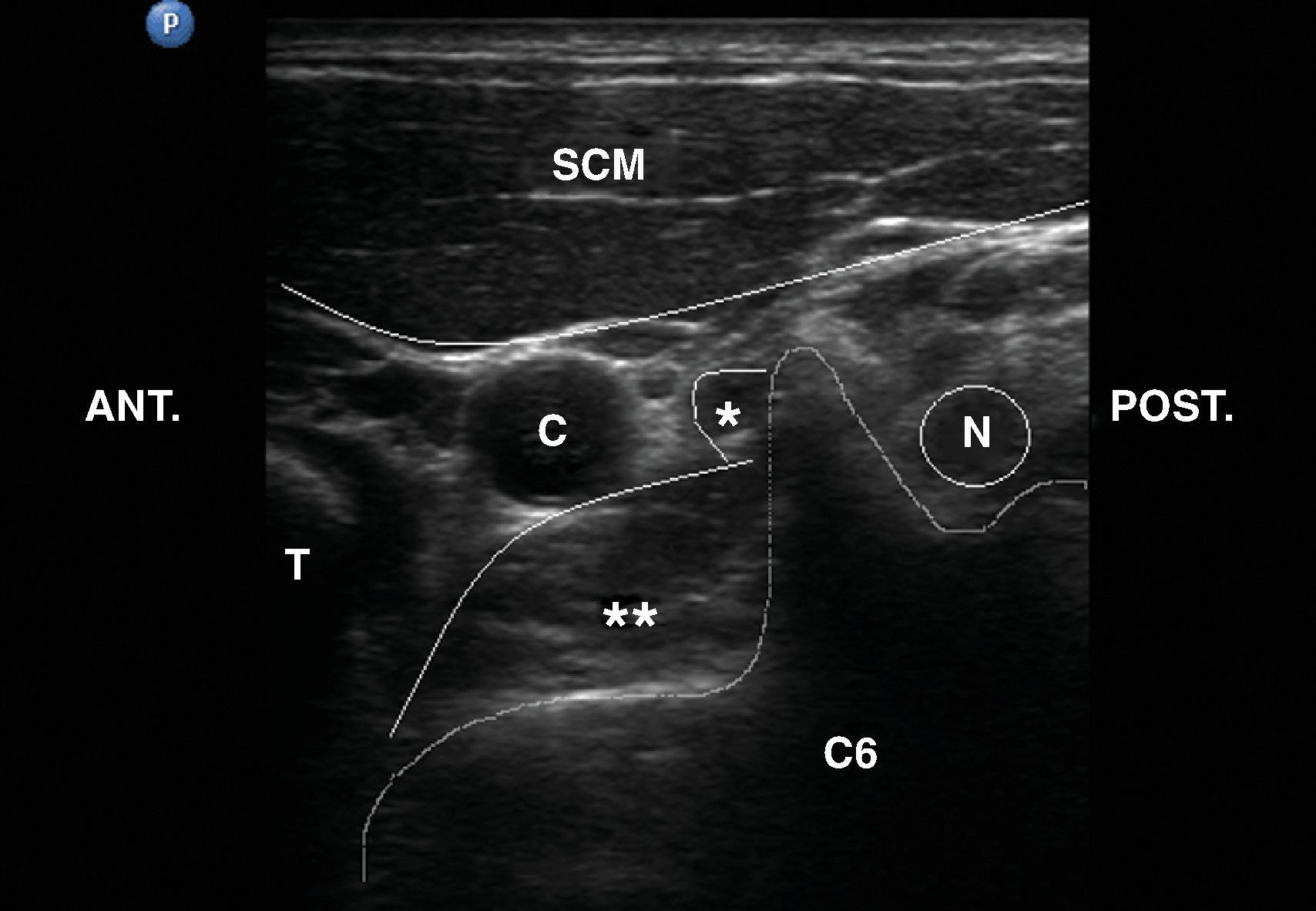
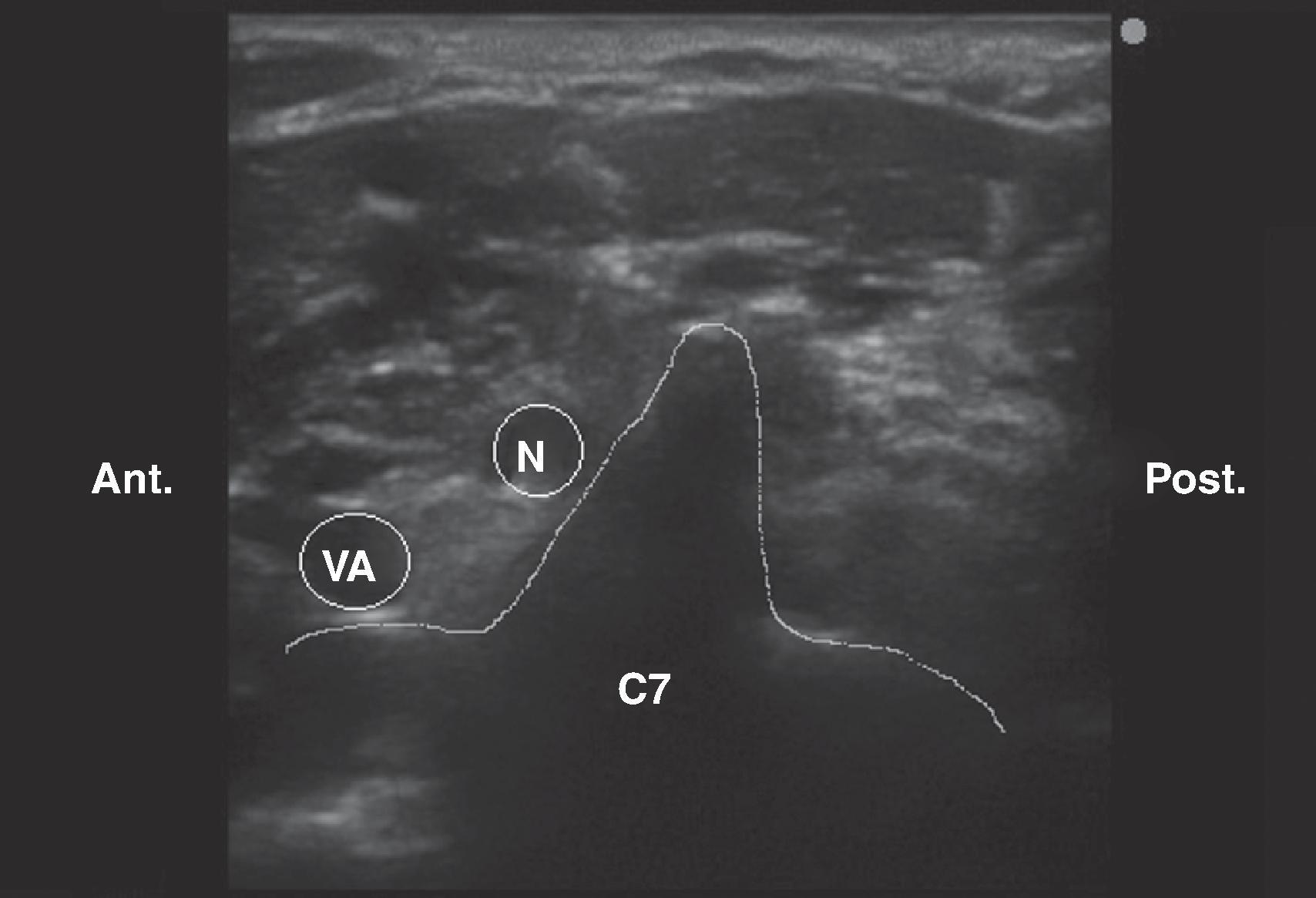
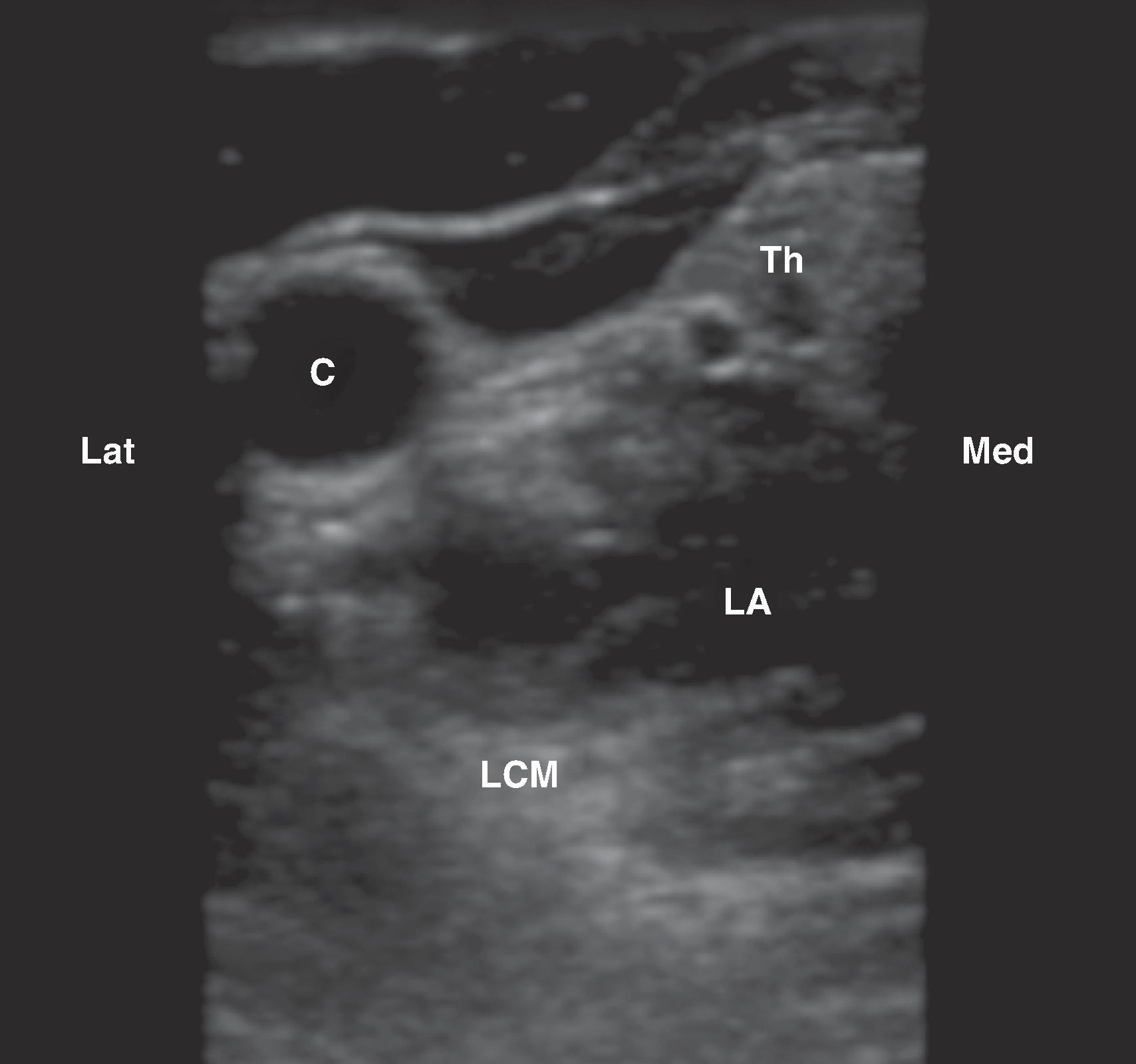
A lateral approach has recently been described and validated. The patient is placed in the lateral decubitus position with the side to be treated uppermost. Preparation and ultrasonography are performed as described previously. The ultrasound transducer is centered on the C6 transverse process and not the anterior aspect of the neck. With the transducer placed as shown in Fig. 63.8 , only the anterior tubercle of the C6 transverse process is visible adjacent to the projected entry point of the needle, and no visceral or neural elements are present between the entry site and the anterolateral surface of the LCM. The needle track is entirely intramuscular and passes through the sternocleidomastoid muscle, the anterior scalene muscle, or both. The internal jugular vein is occasionally seen within the projected needle track, but it can readily be collapsed by placing light pressure on the transducer.
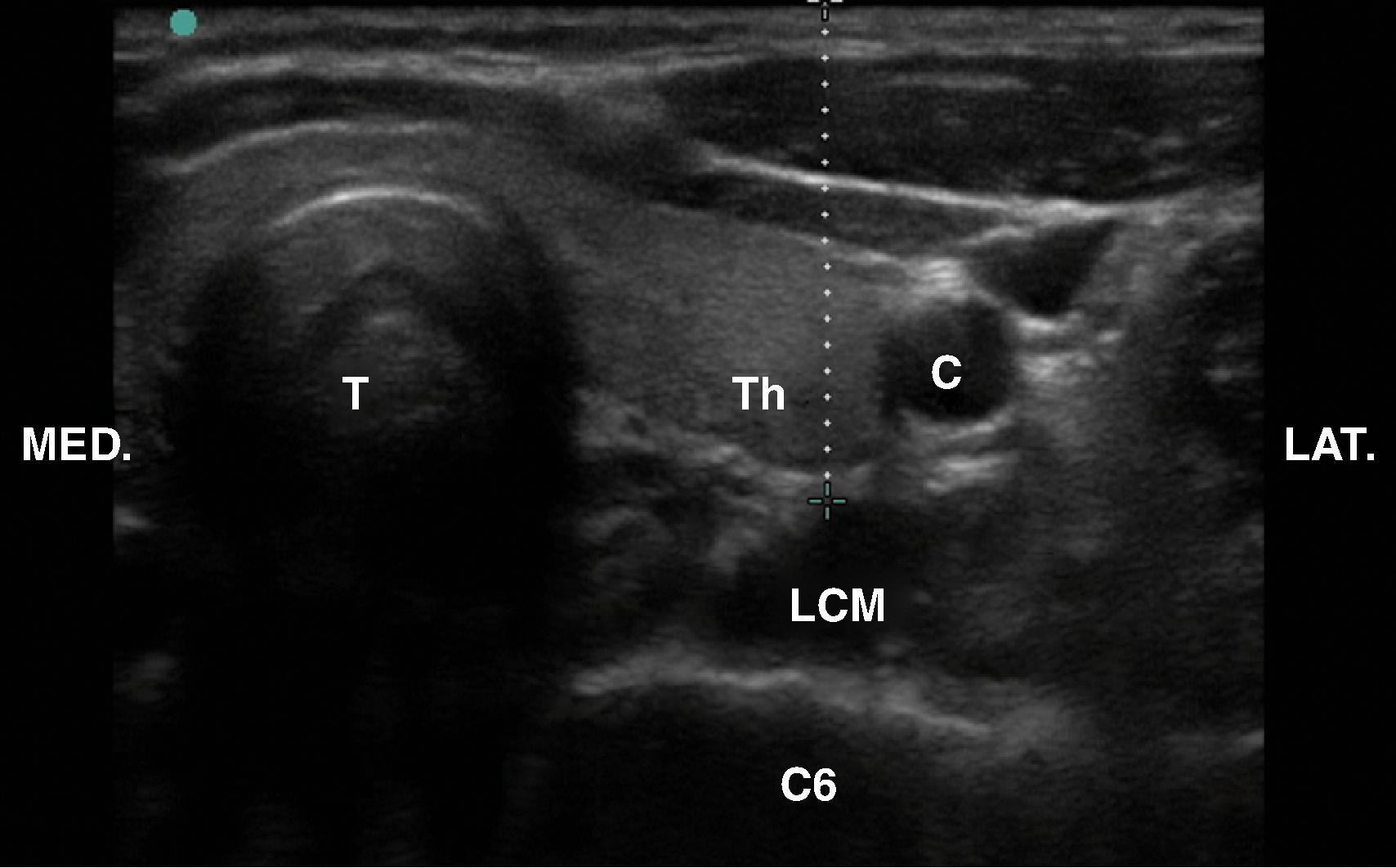
Skin anesthesia is performed immediately posterior to the ultrasound transducer. Under continuous ultrasound guidance, the needle is inserted via a short-axis, in plane technique ( Fig. 63.9 ). The advantage of the lateral approach, besides avoiding trespassing through the thyroid, is totally controllable, visible progression of the needle from the skin entry point to the target. Verification of needle position and performance of the rest of the procedure are the same as the anterior approach.
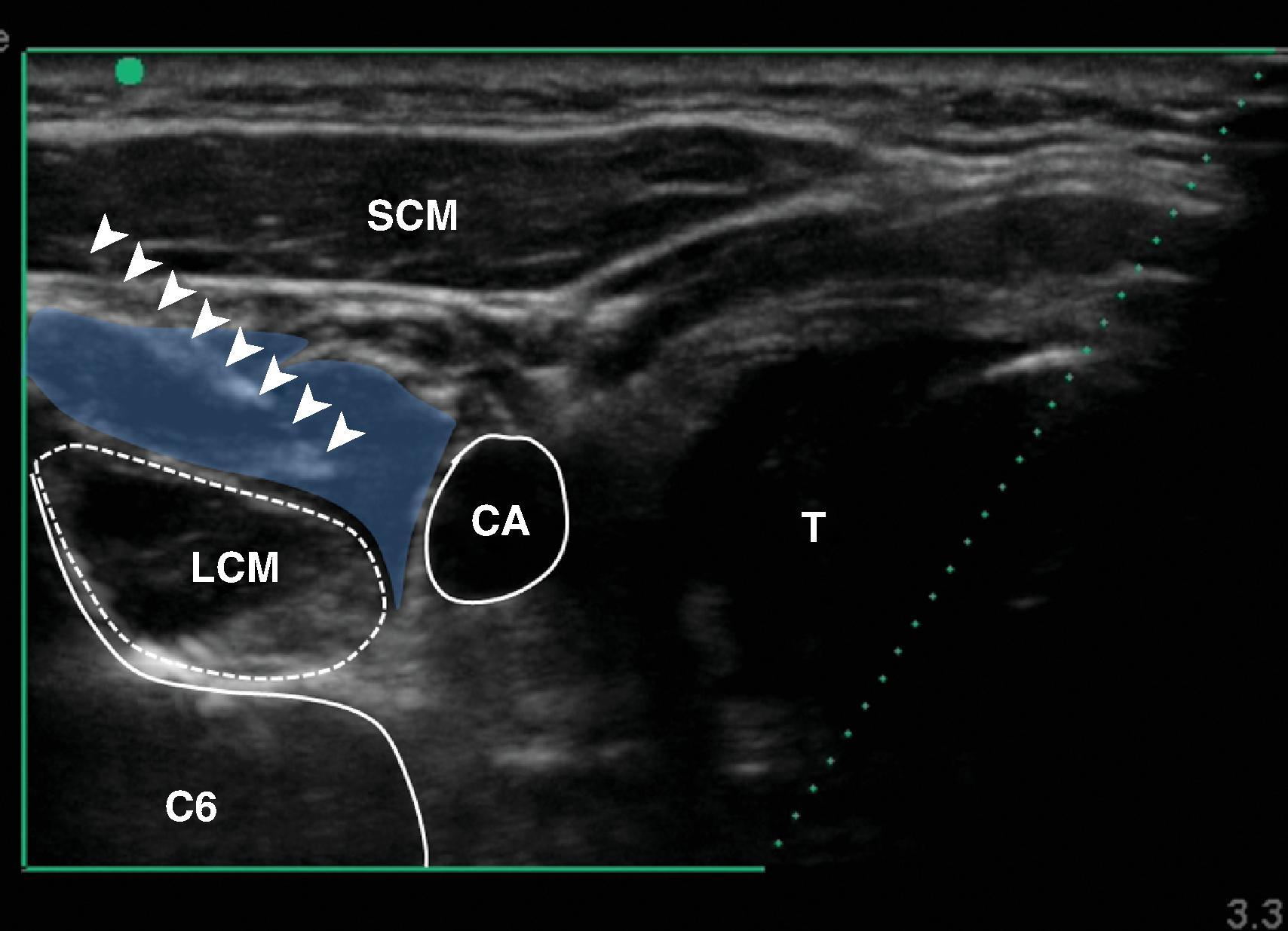
Injection of 5 mL of a local anesthetic typically results in C3-T1 prevertebral spread and complete blockade of the CST and stellate ganglion. If anesthetic blockade of the upper cervical ganglion is not desirable, it would be prudent to limit the volume of the injectant to 3 mL.
Blind paratracheal injection produces unreliable results and is associated with various side effects and complications, such as intravascular injection, formation of hematomas, temporary paralysis of the recurrent laryngeal nerve, diskitis, and esophageal injury. - Narouze and associates further emphasized the risks inherent with a blind approach by pointing out that blind injection at the C6 level on the left side may cause inadvertent esophageal puncture or may traverse the thyroid.
Fluoroscopic guidance may prevent adverse outcomes related to intravascular, nerve root, or neuraxial injection. However, visualization of the soft tissue, vessels, and cervical sympathetic ganglia makes guidance with ultrasound superior to fluoroscopic guidance. Subfascial injection of 5 mL of an injectant reliably produces cervical sympathetic blockade. Ultrasound guidance may prevent the complications and adverse outcomes associated with either blind or fluoroscopically guided techniques.
The complications of intravascular injection of local anesthetic are well known. These include loss of consciousness, apnea, hypotension, and seizures. Local anesthetic blocks of the stellate ganglion have been performed for complex regional pain syndrome, vascular insufficiency of the upper extremities, and hyperhidrosis of the face and upper extremities. Neurolytic blockade of the stellate ganglion has been performed for complex regional pain syndrome when there is consistent relief after diagnostic block with local anesthetic and without prolongation of the duration of pain relief. The overall incidence of complications is 0.17%. The exact incidence of pneumothorax is not known. Aside from Horner’s syndrome, hoarseness, blockade of the brachial plexus, subarachnoid and epidural spread, and cord infarction have been reported. Brachial plexus block is secondary to the needle being inserted too lateral or from the spread of the drug along the prevertebral fascia. Ptosis can be corrected by suspension operation of the upper eyelid. Additionally, retropharyngeal hematomas have been reported, ranging from minimal patient discomfort to complete loss of airway. , An unusual reported complication is transient locked-in syndrome, in which the patient is paralyzed and cannot breathe or speak but can only move their eyes because of accidental intravascular anesthetic injection. These complications led other investigators to use alternative techniques to cervicothoracic sympathectomy, including radiofrequency rhizotomy and thoracoscopic sympathectomy.
Paravertebral sympathetic blocks are performed for the treatment of complex regional pain syndromes, vascular insufficiencies of the lower extremities, phantom limb pain, and other conditions such as hyperhidrosis. Percutaneous thoracic paravertebral sympathetic neurolysis is rarely performed because of the high incidence of pneumothorax. A thoracic surgeon who does a surgical sympathectomy under direct vision usually performs treatment of this region. Lumbar paravertebral sympathetic neurolysis can be more safely performed. In this technique, the needles are placed in the anterolateral surface of L2 or L3. Fluoroscopy is used to confirm the vertebral level of placement, correct position of the needle tip, and adequate spread of the dye along the anterolateral aspect of the vertebral bodies. Although a single needle technique can be used, two needles (one at L2 and the other at L3) are recommended for chemical neurolysis so that a smaller volume can be injected per needle. One to 2 mL of local anesthetic is injected, and if it is followed by a temperature increase, 3–4 mL of 6%–10% phenol is injected per needle. The reported complications of the block include subarachnoid injection secondary to injection near the dural cuff at the intervertebral foramen, sensory and motor block resulting from nerve root injury, paresthesia, and backache. The ureter can be injured from the needle or phenol-induced thrombosis of the branch of the ovarian artery supplying the ureter. Genitofemoral neuralgia occurs in 7%–20% of patients and may last four to five weeks. Postsympathectomy dysesthesias result in numbness and pain in the thigh and may last several months. The use of guidance (fluoroscopy, computed tomography [CT], or ultrasound) is mandatory when neurolytic block of the sympathetic chain is performed. Alternate nonchemical neurolytic techniques, including radiofrequency rhizotomy of the lumbar sympathetic nerves, have been employed to avoid the complications from spillage of the neurolytic agent. However, this technique did not result in long-term relief, although other studies have found benefits. , Compared with phenol neurolysis, incomplete neurolysis appears to be more common with radiofrequency rhizotomy, but the incidence of postsympathectomy neuralgia was higher in the phenol group (33% vs. 11%).
Become a Clinical Tree membership for Full access and enjoy Unlimited articles
If you are a member. Log in here